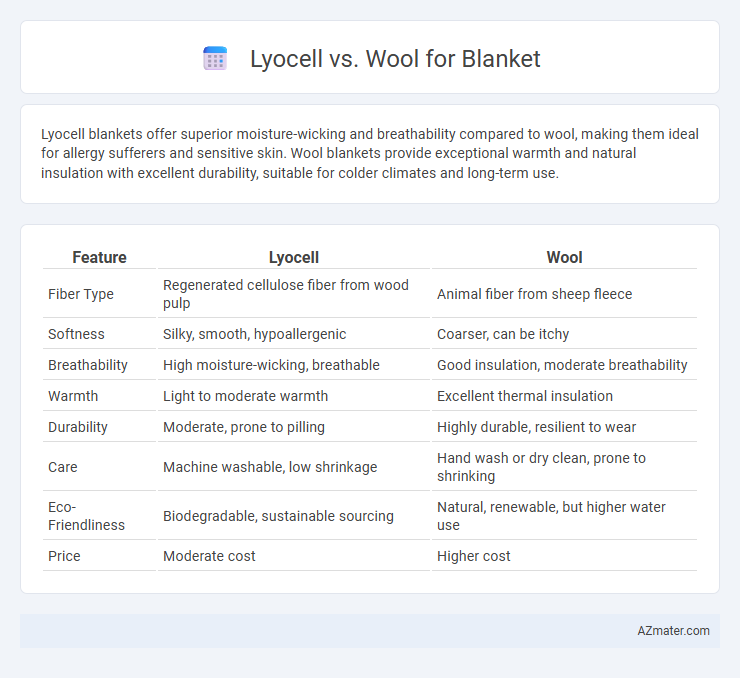Lyocell blankets offer superior moisture-wicking and breathability compared to wool, making them ideal for allergy sufferers and sensitive skin. Wool blankets provide exceptional warmth and natural insulation with excellent durability, suitable for colder climates and long-term use.
Table of Comparison
| Feature | Lyocell | Wool |
|---|---|---|
| Fiber Type | Regenerated cellulose fiber from wood pulp | Animal fiber from sheep fleece |
| Softness | Silky, smooth, hypoallergenic | Coarser, can be itchy |
| Breathability | High moisture-wicking, breathable | Good insulation, moderate breathability |
| Warmth | Light to moderate warmth | Excellent thermal insulation |
| Durability | Moderate, prone to pilling | Highly durable, resilient to wear |
| Care | Machine washable, low shrinkage | Hand wash or dry clean, prone to shrinking |
| Eco-Friendliness | Biodegradable, sustainable sourcing | Natural, renewable, but higher water use |
| Price | Moderate cost | Higher cost |
Introduction to Lyocell and Wool Blankets
Lyocell blankets offer a soft, breathable, and moisture-wicking alternative made from sustainable wood pulp fibers, ideal for allergy sufferers and those seeking eco-friendly bedding. Wool blankets, derived from sheep fleece, provide natural insulation, excellent temperature regulation, and durability, making them perfect for colder climates and winter use. Both materials cater to different preferences in comfort and environmental impact, with Lyocell emphasizing sustainability and breathability, while wool prioritizes warmth and longevity.
Material Origins: Lyocell vs Wool
Lyocell is a sustainable fiber derived from sustainably harvested eucalyptus trees through a closed-loop process that minimizes environmental impact. Wool, sourced from sheep fleece, is a natural protein fiber with renewable properties dependent on animal husbandry. The plant-based origin of Lyocell offers hypoallergenic and moisture-wicking advantages, while wool's animal origin imparts superior insulation and durability.
Softness and Comfort Comparison
Lyocell blankets offer exceptional softness due to their smooth, microfiber structure that feels gentle against the skin, making them ideal for sensitive sleepers. Wool blankets provide natural warmth and breathability with a slightly coarser texture that some find comforting but others may perceive as less soft. Comfort preferences depend on personal sensitivity, with lyocell excelling in silky softness and wool delivering cozy insulation.
Breathability and Temperature Regulation
Lyocell fibers excel in breathability and moisture-wicking, making blankets ideal for maintaining a cool, dry sleep environment. Wool offers exceptional temperature regulation by trapping heat efficiently while remaining breathable, allowing it to adapt to both warm and cold conditions. Blankets made from lyocell provide superior airflow, whereas wool blankets deliver natural insulation paired with moisture management.
Moisture Wicking Abilities
Lyocell fibers excel in moisture-wicking due to their hydrophilic structure, absorbing and releasing moisture quickly to keep the user dry and comfortable. Wool naturally regulates humidity by absorbing moisture vapor without feeling wet, providing excellent breathability and temperature control. Blankets made from Lyocell offer superior moisture management for active sleepers, while wool blankets deliver consistent comfort in varying climates.
Durability and Longevity
Lyocell blankets boast excellent durability due to their strong, cellulose-based fibers that resist wear and maintain softness after multiple washes. Wool blankets provide superior longevity through natural resilience and elasticity, retaining shape and insulation properties over years of use. Both materials offer long-lasting performance, but wool typically outperforms lyocell in sustained durability under heavy, frequent use.
Hypoallergenic and Skin-Friendly Features
Lyocell blankets are highly hypoallergenic due to their natural cellulose fibers, which resist dust mites, mold, and bacteria, making them ideal for sensitive skin or allergy sufferers. Wool blankets, while naturally breathable and moisture-wicking, can sometimes cause irritation or itchiness for those with sensitive skin or wool allergies. Lyocell's smooth, soft texture provides enhanced skin comfort compared to the coarser feel of wool, promoting a gentle and irritation-free sleep experience.
Sustainability and Eco-Friendliness
Lyocell blankets are highly sustainable due to their production from fast-growing, renewable eucalyptus trees using a closed-loop process that recycles almost all chemicals and water, minimizing environmental impact. Wool blankets offer natural biodegradability and renewable sourcing from sheep, but wool production often involves higher water usage and methane emissions, impacting eco-friendliness. Lyocell's lower resource intensity and reduced ecological footprint make it a preferable choice for environmentally conscious consumers seeking sustainable blanket options.
Care and Maintenance Requirements
Lyocell blankets require gentle washing with cold water and mild detergent to maintain their softness and prevent shrinkage, avoiding high heat during drying to preserve fabric integrity. Wool blankets need careful hand washing or dry cleaning to avoid felting, along with air drying flat to maintain shape and prevent stretching. Both fibers benefit from proper storage in a cool, dry place to protect against moisture and pests, ensuring durability and longevity.
Price and Value Considerations
Lyocell blankets generally offer a more affordable price point compared to wool blankets, making them a cost-effective option for budget-conscious consumers. Wool blankets, while pricier due to the natural fibers and complex processing involved, provide superior insulation and durability, enhancing long-term value. Evaluating price against benefits such as breathability, warmth, and maintenance helps determine the best blanket choice for specific needs.

Infographic: Lyocell vs Wool for Blanket
 azmater.com
azmater.com